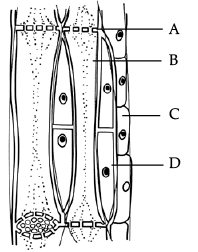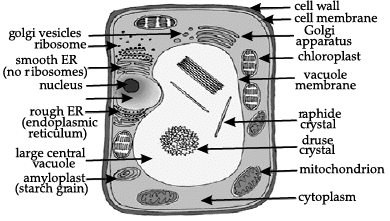Biology Mock Test- 3 - Class 9 MCQ
30 Questions MCQ Test - Biology Mock Test- 3
Direction: Sunil while playing football with his friends got injured suddenly. His friends took him to the hospital and the doctor told that he was suffering from a sprain and advised bed rest. Every afternoon, his friends visited him to enquire about his health.
Q. During a sprain, which type of tissue are stresses?
Direction: Sunil while playing football with his friends got injured suddenly. His friends took him to the hospital and the doctor told that he was suffering from a sprain and advised bed rest. Every afternoon, his friends visited him to enquire about his health.
Q. Dislocation of bones is due to ________
Direction: Study the given diagram and answer the following questions.

Q. Vascular bundles are :

Among the following which is the major cause of crop failure in India?
In the process of ———–substances move across the membrane without the expenditure of ATP.
Direction: Study the given descriptions and answer the following questions.
Tissue ‘A’–Repairs the injured tissues and fills spaces within organs.
Tissue ‘B’–Serves as a fat reservoir and also carries out the function of insulator.
Q. Identify the animal tissue from the given description :
Which of the following tissue has matrix, that is the source of its structural and functional performances?
Direction: Study the diagram of a plan cell and answer the following Questions-

Q. Which cell organelle is involved in synthesis of vacuoles ?
Direction: Study the diagram of a plan cell and answer the following Questions-

Q. The special structures in plant cell known as Kitchen of the Cell
The contractile protein of skeletal muscle involving ATPase activity is
Which of the following are the main constituents of cell wall?
Mixed cropping and intercropping involve growing of two or more crops simultaneously on the same field; but the latter differs from the former in that
Direction: In the following questions, a statement of assertion (A) is followed by a statement of reason (R). Mark the correct choice as:
Assertion: Muscle fibers are contractile in nature.
Reason: Cells of muscle tissue can shorten forcefully and again return to the relaxed state.
Direction: In the following questions, a statement of assertion (A) is followed by a statement of reason (R). Mark the correct choice as:
Assertion : Vascular or conductive tissue is a distinctive feature of complex plants.
Reason : Vascular tissue has made survival of complex plants possible in terrestrial environment.




















